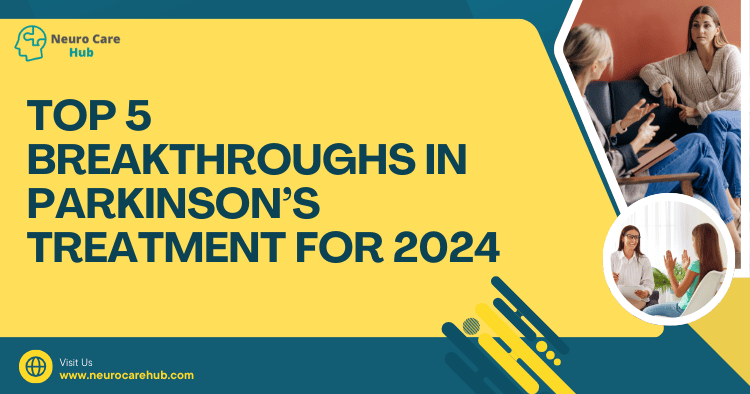Table of Contents
- Introduction
- 1. Gene Therapy Innovations
- 2. New Drug Developments
- 3. Deep Brain Stimulation Enhancements
- 4. Neuroprotective Strategies
- 5. Digital Therapeutics
- Conclusion
- FAQs
Introduction
Parkinson’s disease affects millions worldwide, presenting a unique set of challenges for both patients and caregivers. Fortunately, the landscape of Parkinson’s treatment is shifting rapidly. With numerous breakthroughs on the horizon, 2024 promises to be a landmark year for those affected by this condition. This article explores the top five advancements that are set to transform how Parkinson’s is treated, offering hope and improved quality of life.
1. Gene Therapy Innovations
Gene therapy is making waves in the treatment of Parkinson’s disease. Recent trials have shown promising results in using viral vectors to deliver healthy genes directly to the brain cells affected by Parkinson’s. These therapies aim to restore the production of dopamine, which is severely depleted in patients.
“Gene therapy holds the potential to address the root causes of Parkinson’s, offering a transformative approach to treatment.”
Key Developments:
- AAV2-GDNF Therapy: This therapy uses adeno-associated virus serotype 2 (AAV2) to deliver glial cell line-derived neurotrophic factor (GDNF) directly to the brain. Early trials have noted improvements in motor function and reduced tremors.
- CRISPR Technology: Researchers are exploring CRISPR-Cas9 technology to edit genes associated with Parkinson’s, potentially halting its progression.
For more detailed information on gene therapy advancements, you can check out this NINDS research article.
2. New Drug Developments
Pharmaceutical companies are continuously researching new compounds to improve the management of Parkinson’s symptoms. 2024 has introduced several noteworthy candidates:
“The race for innovative drugs reflects a growing commitment to enhance the lives of those living with Parkinson’s disease.”
Highlights:
- Novel Dopamine Agonists: New formulations that are longer-lasting and have fewer side effects are being developed. For instance, a promising drug called P2B001 has shown efficacy in managing motor symptoms with less frequent dosing.
- Neuroprotective Agents: Drugs like UIS-707, which targets mitochondrial dysfunction, are undergoing clinical trials. These medications aim to not only alleviate symptoms but also slow down disease progression.
You can learn more about ongoing drug trials at ClinicalTrials.gov.
3. Deep Brain Stimulation Enhancements
Deep brain stimulation (DBS) has been a cornerstone of Parkinson’s treatment for years. Recent technological advancements have made DBS more effective and accessible.
“Enhancements in DBS technology are paving the way for more precise and personalized treatments.”
Innovations:
- Closed-loop Systems: Unlike traditional DBS, which delivers constant stimulation, closed-loop systems adjust stimulation based on real-time brain activity. This precision leads to fewer side effects and better symptom control.
- Miniaturized Devices: Newer DBS devices are smaller, rechargeable, and require less invasive procedures, making them more appealing to patients.
A detailed guide on DBS can be found at the American Parkinson Disease Association.
4. Neuroprotective Strategies
The focus on neuroprotection is gaining traction as researchers aim to not only treat symptoms but also protect the brain from damage.
“Investing in neuroprotective strategies could redefine the future of Parkinson’s treatment.”
Emerging Strategies:
- Antioxidants: Compounds like CoQ10 and N-acetylcysteine (NAC) show promise in reducing oxidative stress in neurons, potentially slowing disease progression.
- Lifestyle Interventions: Studies suggest that diet, exercise, and mental health play critical roles in neuroprotection. Programs focusing on aerobic exercise and cognitive engagement are becoming integral to comprehensive treatment plans. For more insights into how lifestyle changes can affect neuro health, refer to Top 5 Lifestyle Changes for Better Neuro Health.
For more on lifestyle interventions, you can refer to the Michael J. Fox Foundation.
5. Digital Therapeutics
In our tech-driven world, digital health solutions are revolutionizing Parkinson’s treatment. These tools not only aid in symptom management but also enhance patient engagement.
“Digital therapeutics are not just innovations; they are essential tools for a more effective management of Parkinson’s disease.”
Notable Tools:
- Mobile Apps: Apps that track symptoms, medication adherence, and daily activities are empowering patients to take control of their health. For instance, the Parkinson’s Progression Markers Initiative (PPMI) app allows users to log daily symptoms and share data with healthcare providers.
- Virtual Reality (VR): VR therapy is being explored to improve motor function and balance through interactive exercises, making rehabilitation both fun and effective. For insights into integrating neuro care into wellness routines, see Top 5 Ways to Integrate Neuro Care into Wellness Routine.
Explore the potential of digital therapeutics at Digital Therapeutics Alliance.
Conclusion
As we step into 2024, the advancements in Parkinson’s treatment are more promising than ever. From groundbreaking gene therapies to innovative digital solutions, these breakthroughs offer new hope for patients and their families. Staying informed about these developments is essential, as they might significantly improve the quality of life for those living with Parkinson’s.
FAQs
Q: What is the most promising new treatment for Parkinson’s?
A: While many treatments are under investigation, gene therapy and closed-loop deep brain stimulation are among the most promising advancements.
Q: Are there any new drugs approved for Parkinson’s in 2024?
A: Several drugs are in the pipeline, with some nearing approval. Keep an eye on updates from clinical trials for the latest information.
Q: How can lifestyle changes impact Parkinson’s?
A: Lifestyle changes, such as regular exercise and a balanced diet, can help manage symptoms and may contribute to neuroprotection.
Q: Where can I find support and resources for Parkinson’s?
A: Organizations like the Parkinson’s Foundation and the Michael J. Fox Foundation offer extensive resources and support for patients and caregivers.
These advancements not only represent hope but also a commitment from the scientific community to improve the lives of those affected by Parkinson’s disease. Stay tuned for more developments in this exciting field!






